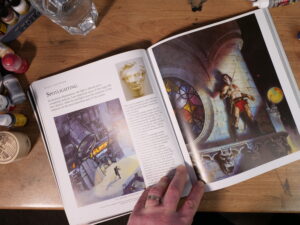The book “Color and Light” by James Gurney, is written for traditional and digital realist painters. But can it be of use to us as modellers?
Is it worth buying and will it help you level up your painting, or will it just look pretty on your shelf?
Well, this book review will explore just that.

Summary
Unlike many resources such as other books,
(or ironically, YouTube videos),
this book is not about giving a step-by-step tutorial on mixing colours or a particular painting technique.
Instead, James, (the author) discusses key principles of how our eyes perceive light and colour working in the real world and then describes how that could apply to our artwork.
He also explores questions such as “is moonlight blue?”, “Should you avoid green?”, or “how does light change – and how does that affect the story I am trying to tell”?
I won’t tell you the answer for the sake of spoilers…. but it was interesting.
The book has over 200 beautifully illustrated pages which cleverly support and demonstrate the points being made.
What did I learn from this book?
I initially checked out this book after it was mentioned in a “Trovarion” video (if you have not seen the Trovarion YouTube channel ( https://www.youtube.com/@trovarion ), you should check it out later as he is an amazing artist and teacher).
So when I came to this book as a modeller, I was very aware that it was written for 2D images rather than the 3 dimensions that we work in.
However, while it covers some very technical areas, it makes them fairly easy to get your head around.
On that note, who would have thought there were that many different types of shadow!
I can honestly say that there were loads of points in this book which contained jaw-dropping, mind-blowing moments.
That sort of moment when now you have seen it, you cannot unsee it.
It sounds very cliche, but it makes you see rather than “just” look.
For example, I started noticing what was there when using reference images, rather than what I thought “should” be there.
Strengths and Weaknesses
While you may have guessed that I love this book, it isn’t perfect. So what are the strengths and weaknesses of this book?


Weaknesses
-
This book is written for traditional and digital 2D artists. Therefore some elements may be less useful for us as modellers (such as painting sky panels or colour scripting).
- You do need to think about it... This may sound silly, but it is not designed to be a step-by-step tutorial. You have to take the knowledge and figure out how it applies to your project which can be a learning curve in itself.
Strengths
- As it is so easy to read, I would say that it's suitable for beginners through to advanced painters.
- As your experience grows, you can easily refer back and get even more from it.
- It is beautifully illustrated throughout which demonstrates the point being made.
- The pages are made from thick enough paper to stand up to being regularly thumbed through to check something.
- While this book is written for 2D artists, it still helps you understand what to look for and why. This can help us apply that "theory" to our models to take them to the next level.
Final Recommendation
I was once told by a very wise lecturer that;
First, we learn what to do,
Then we learn why we do it…
Finally, we learn how to do it in style… it’s about learning to do it in style.
If you are coming from the right direction, then it could potentially (and with time and practice) help you on all three of those levels.
However, this is only the case if you want to use colour and lighting on your model to help tell a story. Likewise, if you want a “step-by-step” guide, then this book is not for you.
However, if you want to tell a story with your model (whatever scale or genre it is), or you want to delve deeper into painting for competitions, then I would recommend getting hold of a copy. Not only that, but reading the sections you are interested in right now and keeping it to hand for reference in the future.
Want to check it out?
“Color and Light” is available now and you can check it out on my website here